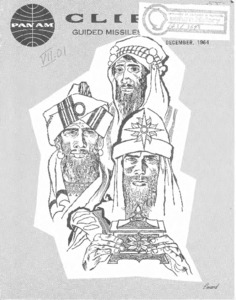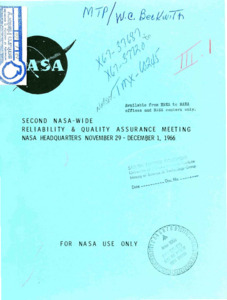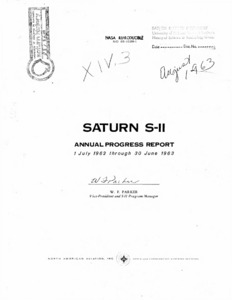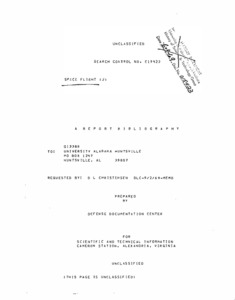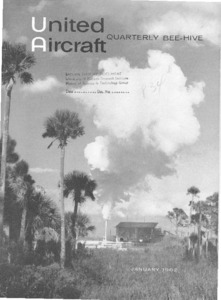
Browse Items (970 total)
Sort by:
-
"H-1 rocket engine: models H-1C and H-1D : technical manual engine data."
Poor jpeg of a screenshot of a word-document. -
"NEXUS concept of a large reusable earth launch vehicle."
Aspects of Earth-to-orbit delivery are discussed and a cost analysis of the logistic operation and the cost of orbital operations are presented. Probabilities of success of orbital delivery and the operational and economic aspects of establishing large orbital installations and maintaining a large transportation volume in the 1975/85 time period are compared for the two cases using a large number of Saturn V versus a smaller number of 1-stage chemical Post-Saturn launch vehicles. Performance parameters of chemical, chemonuclear and nuclear launch vehicles are compared. The concept of a blunt launch vehicle configuration referred to as NEXUS is presented in detail. Applications of this configuration to chemonuclear propulsion and to a 50 ft diameter version of Saturn V with recoverable first stage are discussed. -
"Pan Am Clipper : Guided Missiles Range Division : December, 1964."
A collection of articles, one of which musing about the landing on/colonization of Mars in the future. -
"Outline of the capability of technical facilities and equipment at the George C. Marshall Space Flight Center."
Outline of the equipment present at George C. Marshall Space Flight Center. -
"Propulsion and Vehicle Engineering Laboratory monthly progress report (April 1, 1966 through April 30, 1966)."
Progress report for the month of April, 1966. -
"Proceedings : second NASA-wide reliability & quality assurance meeting : NASA Headquarters, November 29 - December 1, 1966."
The papers presented at the second NASA-Wide Reliability and Quality Assurance Meeting are published to disseminate current experiences and information. These papers, presented at NASA Headquarters on November 29 - December 1, 1966, are one means of exchanging current NASA reliability and quality assurance knowledge between projects and programs. This publication has been marked "FOR NASA USE" since it contains management opinions and contract experiences. Publication of papers suitable for wide dissemination in the Government, industry and University community is expected to be made separately. John E. Condon, Director, Reliability & Quality Assurance. -
"Preliminary skeletal operations plan for Apollo :" a systems engineering support document.
The Preliminary Skeletal Operations Plan is a statement of the operational concept for Apollo. This draft contains a description of the conduct of the Apollo LOR landing mission and a mission profile. It provides the basis for more detailed mission planning, for generating functional criteria for equipment design, and for measuring the adequacy of the current Apollo hardware for satisfying operational needs. -
"Pratt & Whitney Aircraft RL10 liquid hydrogen rocket engine"
Photograph of a Pratt & Whitney rocket engine. -
"R & D directory for 1962 (NASA-MSFC Contracts-1962)."
Excerpt of contracts MSFC 1962, pages 76-79. -
"Propulsion and Vehicle Engineering Laboratory monthly progress report (March 1, 1966 through March 31,1966)."
A collection of progress reports covering a large number of projects within the month of March, 1966 -
"Propulsion and Vehicle Engineering Laboratory monthly progress report (November 1, 1966 through November 30, 1966)."
A collection of progress reports covering a large number of projects within the month of November, 1966 -
"Propulsion and Vehicle Engineering Laboratory monthly progress report (August 1, 1966 through August 31, 1966)."
A collection of progress reports covering a large number of projects within the month of August, 1966 -
"Propulsion and Vehicle Engineering Laboratory monthly progress report (July 1, 1966 through July 31,1966)."
A collection of progress reports covering a large number of projects within the month of July, 1966 -
"Project Thor (u): a report Bibliography."
Unclassified control No. 015415.; Requested by D.L. Christensen, DLC-5/2/69-Memo for Scientific and Technical Information, Cameron Station, Alexandria. -
"Project Dynasoar (u): a report bibliography."
Projected by D.L. Christiansen, DLC- 5/2/69-Memo.; Search control No. 015416.; For Scientific and Technical Information, Cameron Station, Alexandria, Virginia.; Unclassified.; Pages in this bibliography are not numbered. -
"A review of the research origins of the LANCE weapon system -- Project hindsight -- Task 1 supplement."
This report includes a discussion of 57 research and exploratory development events that have been identified as contributing significantly to LANCE. Forty-six of these are research events. Eight of the research events deal with LANCE aerodynamics, four with propulsion, 24 with solid-state components used in the guidance and control system,and 10 with the research origins of the materials and manufacturing processes used in LANCE. In addition, 11 exploratory development events are identified. The principal concern of this study has been the identification of further research origins of LANCE and the 46 documented events are its major product. A further concern and obligation of this study has been to provide HINDSIGHT with some additional data on the research phenomenon including some further observations on the nature and route of research utilization.; FOREWORD: The purpose of this report is to present a survey of fundamental research contributing to the successful development of the LANCE weapon system. Included in this report are discussions of research inputs to a number of LANCE systems and technology areas. The circumstances of these research contributions to LANCE are discussed. The implications of these examples of research utilization are analyzed and some general observations and conclusions on the research payoff phenomena are given. This report was requested by the Army Missile Command as a supplemental contribution to Project HINDSIGHT.; Contract No. DA-01-021-AMC-14693(Z).; Battle Memorial Institute ,Columbus Laboratories.; RSIC-627.; Includes letter from W. Metscher, Lt. Col. to Mr. David L. Christensen dated March 14, 1969. -
"Ground testing at MSFC : research achievements review series no 9"
In 1955, the team which has become the Marshall Space Flight Center (MSFC) began to organize a research program within its various laboratories and offices. The purpose of the program was two-fold: first, to support existing development projects by research studies and second, to prepare future development projects by advancing the state of the art of rockets and space flight. Funding for this program came from the Army, Air Force, and Advanced Research Projects Agency. The effort during the first year was modest and involved relatively few tasks. The communication of results was, therefore, comparatively easy.; Pages of handwritten notes on yellow legal paper. There is also a 3 x 5 inch card with this information. Article reference for Saturn History Files: Schuler, Albert E. (NASA-MSFC) Research and development in instrumentation for static testing. -
"Report to the Congress from the President of the United States"
A report to Congress from White House regarding the accomplishments of NASA. -
"Saturn technical information handbook. Volume III of four volumes : SA-203."
The "Saturn Technical Information Handbook" provides up-to-date reference material to the Launch Operations Center personnel. This material shows the assembly and operation of the Saturn Vehicle components for systems analysis.; Volume II is available on the NASA Technical Reports Server (NTRS) as a PDF. -
"Saturn IB inflight photographic instrumentation system."
This Internal Note presents the development of the Saturn inflight photographic instrumentation program from its original development requirement concept to the flight hardware application on Saturn vehicles. A comprehensive description of the infight photographic instrumentation system is given along with data concerning testing, operation, application, and evaluation of the system after recovery. This Internal Note shows that the system has been successfully developed,that valuable information has been obtained from film retrieved from recovered capsules, and that the system can be used with a high degree of reliability. -
"Saturn S-II stage program plan."
This documents outlines the S & ID plan to fulfill the requirements of Contracts NAS7-80 and NAS7-200 for the design, development and manufacture of the Saturn S-II stage.; APPROVED by R E. Greer, Vice President and S-II Program Manager.; This reissue supersedes all previous issues of this report.; FOREWORD: The S-II stage is 81.5 feet in length and 33 feet in diameter, with a usable propellant capacity of 970,000 pounds, The S-II propellants are fully cryogenic-liquid oxygen at -279 F and liquid hydrogen at -423 F. Its five-engine cluster provides one million pounds of thrust. The stage is a cylindrical structure of relatively light weight with a shell designed to resist all loads without the use of stiffening members. Its skin is of welded aluminum panels, as are the elliptical bulkheads of the fuel and oxidizer tanks. Unique to its design is the common bulkhead that separates the -423 F liquid hydrogen from the -247 F liquid oxygen. The common bulkhead - a sandwich of two 33-foot diameter aluminum domes separated by an insulating filler of honeycomb - eliminates the weight penalty that would be imposed by the second bulkhead in more conventional design. This document describes the S & ID program plan for development of the S-II stage and associated a support equipment. -
"Saturn S-II annual progress report 1 July 1963 through 30 June 1964."
This document is the second annual progress report of the Saturn S-II Program. The report provides a summary and technical analysis of results of contract work by the Space and Information Systems Division of North American Aviation, Inc., for the period 1 July 1963 through 30 June 1964. This document was prepared in compliance with NASA contract NAS7-200. -
"Saturn S-II : annual progress report : 1 July 1962 through 30 June 1963."
This document, prepared in compliance with NASA contract NAS7-200, is the first annual progress report on the Saturn S-11 Program at the Space and Information Systems Division of North American Aviation, Inc. It provides a summary- and a technical analysis of results of contract work for the period 1 July 1962 through 30 June 1963.; SID 63-1028-1 251 pages. Include illustrations. -
Saturn V project development plan : November 1967.
This document revises and supersedes the Saturn V Project Development Plan, dated March, 1967. Approved: Arthur Rudolph, Manager, Saturn V Program; Samuel C. Phillips, Major General, USAF, Director, Apollo Program. -
Saturn V management information : August 1964 : Volume VI.
This document contains copies of management charts maintained in the Managerial Data Center of the executive Staff on the Saturn V project. To facilitate use of this document, all Saturn V classified data has been removed and will be published in Volume XI. A list of these charts are shown on the "Table of Contents". Information on other MSFC activities will be published in separate volumes as indicated on the "Schedule for Publication of Data Bank Charts" contained in this volume. -
"Saturn system study II."
Study regarding the three-stage carrier vehicle E-1 engines. -
"Space Station operations analysis using Gemini-Titan II-Agena."
Copy No. 026. Ger-10866. -
Spaceflight: DDC report bibliography.
Bibliography containing space crews, space flights, satilites, cryogenic propellants, propaganda and the USSR. -
Space age vision [photograph].
8 x 10 inch black and white photograph. -
Source credibility and personal influence in three contexts : a study of dyadic communication in a complex aerospace organization.
Abstract to "A thesis submitted to the faculty of Purdue University fo Gary Marshall Richetto in partial fulfillment of the requirements for the degree of Doctor of Philosophy, January 1969".; Handwritten note on front page: Return to Internal Communication, Room 223, 4202. -
"Statement of George E. Mueller, Associate Administrator for Manned Space Flight."
Volume I - Text. A statement given by George E. Mueller to the Committee of Aeronautical and Space Sciences. -
"University and research institute contracts awarded by MSFC."
This is a list of contract numbers, contractor, subject and RNT contact. -
"United Aircraft Quarterly Bee-hive:" Spring, 1962: Volume XXXVII, Number 2.
A book containing various articles surrounding the activities and achievements of the Saturn program up to Spring, 1962. -
"United Aircraft Quarterly Bee-hive:" January 1962, Volume XXXVII, Number 1.
A book containing various articles surrounding the activities and achievements of the Saturn program up to January, 1962. -
A "Think Clean" training program.
This paper outlines steps involved in preparing and presenting an instruction course on clean rooms. The training area, personnel, equipment, and program outline will be described. A summary of the results obtained over the first year of operation will be presented. -
Various organization charts of NASA-MSFC during 1960-1969.
A collection of organization charts from years 1960 to 1969. -
"Crew Briefing : Instrument Unit Stage Presentation".
Document outlining different slides of a presentation containing numerous organizational charts, diagrams and bullet-list points. -
"Countdown to Liftoff".
This is an article from the Boeing Magazine. The Archive copy is a very poor photocopy and is difficult to read.; About the time the S-IC-1 booster is lifting the first Apollo/Saturn V from the launch pad on its maiden unmanned flight next year, a Boeing systems test crew will begin static testing the S-IC-4 at Devils Swamp, Mississippi (MTF). Starting with S-IC-4, all Saturn V first stage boosters will be captive fired at MTF. At present, S-IC firings are conducted by MSFC's test laboratory at Huntsville. The first flight stage, the S-IC-1, was placed in the static test stand on 24 January 1966 and completed its test program 25 Feb. It was removed from the stand March 14 and is undergoing post-firing checkout. it is due to be shipped this summer to KSC where it will be mated to the two upper stages of Saturn V, the IU and Dummy Apollo payload. The S-IC-2 went into the static stand on March 22 and is being tested during April The S-IC-3 also will be tested at Huntsville in 1966. The job of putting the world's largest and most powerful rocket together will be accomplished in the world's largest building, the 52-story vehicle assembly building. -
"Corrosion Problems Associated with Space Launch Vehicles".
A document reporting various space vehicle corrosion issues. Original is photocopy. -
Convective Energy Transport in Stellar Atmospheres: A Convective Cell Model.
One of the Orange Aid Preprint Series in Nuclear Astrophysics, September 1968.; Supported in part by the National Science Foundation [GP-7976], the Office of Naval Research [Nonr-220(47)]. ; ABSTRACT: The motion in a convectively unstable region is expanded into an ensemble of convective cells. Each of these cells interacts with the surrounding medium according to the semiempirical model proposed by Turner (1963 ). Possible detailed models of the flow patterns within each cell are presented. The radius and velocity of these cells are given as functions of distance moved. The convective flux and rms velocity are given as averages over the ensemble of cells. As in the standard mixing length theory the principle uncertainty remains the average initial radius of the cells.


